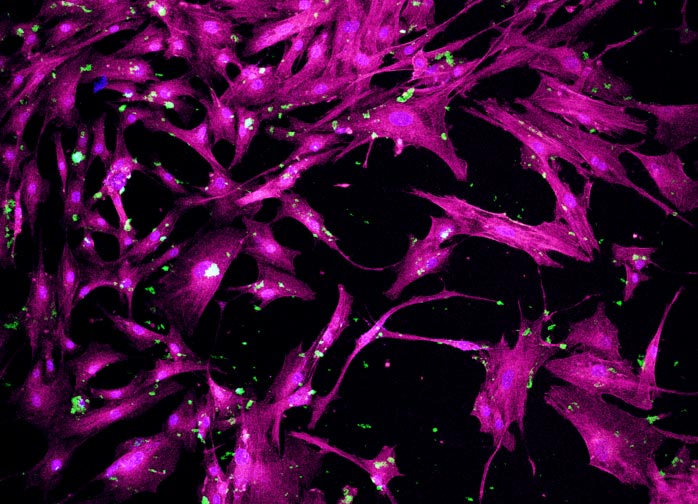Engineering researchers develop porous nanoparticles for regenerative medicine

Dr. Akhilesh K. Gaharwar is leading research to develop a new class of porous nanoparticles that can direct stem cell differentiation. In the photo, the purple sections are actin cytoskeleton of human mesenchymal stem cells, the blue spot in the upper left area is the nucleus of cells and the green represents 2D covalent organic framework nanoparticles.
Credit: Dr. Akhilesh K. Gaharwar/Texas A&M Engineering
A Texas A&M team’s findings could have implications for the treatment of bone regeneration.
Stem cells can develop into many different types of cells in the body. For instance, when a person is injured, stem cells come to the site of the injury and aid in healing damaged tissues. New nanotechnology developed by a team of researchers from Texas A&M University could leverage the body’s regenerative potential by directing stem cells to form bone tissue.
Akhilesh K. Gaharwar, associate professor and Presidential Impact Fellow in the Department of Biomedical Engineering and a fellow of the American Institute for Medical and Biological Engineering, leads the team. The researchers have developed water-stable, 2D covalent organic framework (COF) nanoparticles that can direct the differentiation of human mesenchymal stem cells into bone cells.
Significant research attention has been given to 2D COFs — porous organic polymers — due to their crystallinity, ordered and tunable porous structure, and high specific surface area. However, the difficulty of processing COFs into nanosized materials — along with their poor stability — has limited their application in regenerative medicine and drug delivery. There is a need for new approaches that provide these COFs with sufficient physiological stability while maintaining their biocompatibility.
Gaharwar’s team has enhanced the hydrolytic (water) stability of COFs by integrating them with amphiphilic polymers, which are macromolecules that contain both hydrophobic and hydrophilic components. This approach, which has not been reported previously, gives water dispersibility to COFs, enabling biomedical application of these nanoparticles.
“To the best of our knowledge, this is the first report demonstrating the ability of COFs to direct stem cells toward bone tissue,” Gaharwar said. “This new technology has the potential to impact the treatment of bone regeneration.”
The researchers found that 2D COFs do not affect a cell’s viability and proliferation, even at higher concentrations. They observed that these 2D COFs exhibit bioactivity and direct stem cells towards bone cells. The preliminary study indicated that the shape and size of these nanoparticles can impart this bioactivity, and additional in-depth studies need to be carried out for mechanistic insights.
These nanoparticles are highly porous, and Gaharwar’s team has leveraged this unique characteristic for drug delivery. They were able to load an osteo-inducing drug called dexamethasone into the porous structure of the COF to further enhance bone formation.
“These nanoparticles could prolong delivery of drugs to human mesenchymal stem cells, which are commonly used in bone regeneration,” said Sukanya Bhunia, senior author of the study and postdoc associate in the biomedical engineering department. “The sustained delivery of the drug resulted in enhanced stem cell differentiation toward bone lineage, and this technique can be used for bone regeneration.”
Gaharwar noted that, having provided a proof-of-concept, the team’s next step in its research will be to evaluate this nanotechnology in a diseased model.
These findings are important for the future design of biomaterials that can give directions for tissue regeneration and drug delivery applications.
The results were published in Advanced Healthcare Materials journal. Other research contributors are Manish Jaiswal, Kanwar Abhay Singh and Kaivalya Deo from the biomedical engineering department at Texas A&M. The research was supported by the National Institute of Biomedical Imaging and Bioengineering of the National Institutes of Health.
Journal: Advanced Healthcare Materials
DOI: 10.1002/adhm.202101737
Method of Research: News article
Article Title: 2D Covalent Organic Framework Direct Osteogenic Differentiation of Stem Cells
Article Publication Date: 1-Feb-2022
All latest news from the category: Health and Medicine
This subject area encompasses research and studies in the field of human medicine.
Among the wide-ranging list of topics covered here are anesthesiology, anatomy, surgery, human genetics, hygiene and environmental medicine, internal medicine, neurology, pharmacology, physiology, urology and dental medicine.
Newest articles

Combatting disruptive ‘noise’ in quantum communication
In a significant milestone for quantum communication technology, an experiment has demonstrated how networks can be leveraged to combat disruptive ‘noise’ in quantum communications. The international effort led by researchers…

Stretchable quantum dot display
Intrinsically stretchable quantum dot-based light-emitting diodes achieved record-breaking performance. A team of South Korean scientists led by Professor KIM Dae-Hyeong of the Center for Nanoparticle Research within the Institute for…

Internet can achieve quantum speed with light saved as sound
Researchers at the University of Copenhagen’s Niels Bohr Institute have developed a new way to create quantum memory: A small drum can store data sent with light in its sonic…





















